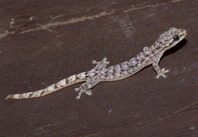Abstract
The new species is consistent with Gymnapogon, a distinct genus having one to three spines on the preopercle edge, fused hypurals (parhypural+1+2 and 3+4+terminal central), a free fifth hypural, two epurals, no supraneurals, scaleless head and body, a single rod-like postcleithrum and complex lines of free neuromasts on the head, body and caudal fin. The new species is distinguished by having a combination of a rounded caudal with 15 branched principal caudal-fin rays, 2 unbranched principal caudal-fin rays, 10 soft dorsal rays with the anterior two rays unbranched, 9 or 10 anal rays with the first ray unbranched and 14 pectoral rays the lower three and upper two unbranched. Nominal species Gymnapogon annona, G. foraminosus, G. japonicus, G. urospilotus and G. vanderbilti have 9 or 10 soft dorsal, 9 or 10 anal rays and 12 to 14 pectoral rays, the lower two and upper two unbranched. Gymnapogon africanus, G. melanogaster and G. philippinus have 9 soft dorsal rays, the first ray unbranched and 8 soft anal rays, the first ray branched. Gymnapogon japonicus has a rounded caudal fin with 13, 14 or 15 branched principal caudal rays. Gymnapogon africanus, G. annona, G. melanogaster, G. philippinus, G. urospilotus and G. vanderbilti have a forked caudal fin with 13 branched principal caudal rays and 2 unbranched upper and lower principal caudal rays. A single preopercle spine distinguishes the new species from the single bifid-like preopercle spine shared by Gymnapogon annona, G. melanogaster and undescribed forms. The wide-spread B-marked species complex made up of Gymnapogon urospilotus, G. vanderbilti and undescribed forms have at least one small upper preopercle spine in addition to the larger single spine near the angle of the preopercle.
References
Bleeker, P. (1865) Enumération des espèces de poissons actuellement connues de l'île d'Amboine. Nederlandsch Tijdschrift voor de Dierkunde, 2, 270–276.
Eschmeyer, W.N., Fricke, R. & van der Laan, R. (2016) Catalog of Fishes: Genera, Species, References. Electronic version. Available from: http://researcharchive.calacademy.org/research/ichthyology/catalog/fishcatmain.asp (accessed 30 March 2016)
Fowler, H.W. (1938) The fishes of the George Vanderbilt South Pacific Expedition, 1937. Monographs of the Academy of Natural Sciences of Philadelphia, 2, i–v+1–349.
Fraser, T.H. (1972) Comparative osteology of the shallow water cardinal fishes (Perciformes: Apogonidae) with references to the systematics and evolution of the family. Ichthyological Bulletin of the J. L. B. Smith Institute of Ichthyology, 34, i–v + 1–105.
Fraser, T.H. (2005) A review of the species in the Apogon fasciatus group with a description of a new species of cardinalfish from the Indo-West Pacific (Perciformes: Apogonidae). Zootaxa, 924, 1–30.
Fricke, R. & Eschmeyer, W.N. (2016) Guide to Fish Collections in the Catalog of Fishes. California Academy of Sciences. Electronic version. Available from: http://researcharchive.calacademy.org/research/Ichthyology/catalog/fishcatmain.asp (accessed 30 March 2016)
Gon, O. & Golani, D. (2002) A new species of the cardinalfish genus Gymnapogon (Perciformes, Apogonidae) from the Red Sea. Ichthyological Research, 49 (4), 346–349.
Hayashi, M. (1984) Apogonidae. In: Masuda, H., Amaoka, K., Araga, C., Uyeno, T. & Yoshino, T. (Eds.), The fishes of the Japanese Archipelago. Tokai University Press, Tokyo, pp. 143–151.
Jordan, D.S. (1923) A classification of fishes including families and genera as far as known. Stanford University Publications, University Series, Biological Sciences, 3 (2), 77–243.
Lachner, E.A. (1953) Family Apogonidae: cardinal fishes. In: Fishes of the Marshall and Marianas Islands. Bulletin of the United States National Museum, 202 (1), 412–498.
Leis, J.M., Meyer, O., Hay, A.C. & Gaither, M.R. (2015) A coral-reef fish with large, fast conspicuous larvae and small, cryptic adults. Copeia, 103 (1), 78–86.
http://dx.doi.org/10.1643/CG-14-119Mabuchi, K., Fraser, T.H., Song, H., Azuma, Y., & Nishida, M. (2014) Revision of the systematics of the cardinalfishes (Percomorpha: Apogonidae) based on molecular analyses and comparative reevaluation of morphological characters. Zootaxa, 3846 (2), 151–203.
http://dx.doi.org/10.11646/zootaxa.3846.2.1Regan, C.T. (1905) On a collection of fishes from the inland sea of Japan made by Mr. R. Gordon Smith. Annals and Magazine of Natural History, Series 7, 15 (85), 17–26.
Regan, C.T. (1940a) The perciform genera Gymnapogon and Nannatherina. Copiea, 1940 (3), 173–175.
Regan, C.T. (1940b) LV.–The perciform genera Gymnapogon and Nannatherina. Journal of Natural History, Series 11, 6 (36), 527–530.
Shao, K.T. (2015) The Fish Datebase of Taiwan. WWW Web electronic publication. Available from: http://fishdb.sinica.edu.tw (accessed: 31 October 2015)
Shen, S.-C. (1993) Fishes of Taiwan. Department of Zoology, National Taiwan University, Taipei, 896 pp.
Smith, J.L.B. (1954) Apogonid fishes of the subfamily Pseudamiinae from south-east Africa. Annals and Magazine of Natural History, Series 12, 7 (82), 775–795.
Springer, V.G. & Smith-Vaniz, W.F. (2008) Supraneural and pterygiophore insertion patterns in carangid fishes, with description of a new Eocene carangid tribe, †Paratrachinotini, and a survey of the anterior anal-fin pterygiophore insertion patterns in Acanthomorpha. Bulletin of the Biological Society of Washington, 16, 1–73.
http://dx.doi.org/10.2988/0097-0298(2008)16[1:SAPIPI]2.0.CO;2Tanaka, S. (1915) Ten new species of Japanese fish. Dobutsugaku Zasshi (Zoological Magazine), 27, 565–568. [in Japanese, translation by Kiyomatsu Matsubara in 1950 at California Academy of Sciences; an English translation in Jordan 1923]
Tomiyama, I. (1936) Gobiidae of Japan. Japanese Journal of Zoology, 7 (1), 37–112.
Whitley, G.P. (1936) More ichthyological miscellanea. Memoirs of the Queensland Museum, 11, (1), 23–51.

